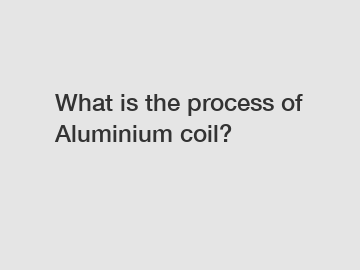What is the process of Aluminium coil?
Aluminium coil is a widely used industrial product that is essential in various industries such as construction, automotive, and aerospace. The process of manufacturing aluminium coil involves several steps to produce high-quality, durable coils that meet industry standards. Understanding the process of aluminium coil production can help in appreciating the complexity and precision involved in creating this versatile material.
### Melting and Casting.
The first step in the process of making aluminium coil is melting the raw materials. Aluminium is typically sourced from bauxite ore, which is refined into alumina before being smelted in a furnace. The molten aluminium is then poured into a large slab caster to form ingots. These ingots are then rolled into thinner sheets, which will be used to make aluminium coils.

### Hot Rolling.
The next step in the process is hot rolling, where the sheets are heated and passed through a series of rollers to reduce their thickness. This process involves high temperatures and pressures to manipulate the aluminium into the desired dimensions. The hot rolling process also helps to improve the mechanical properties of the material, making it more suitable for further processing.
### Cold Rolling.
After the hot rolling process, the aluminium sheets are cold-rolled to further reduce the thickness and improve the surface finish. Cold rolling involves passing the sheets through a series of rollers at room temperature, which increases the strength and hardness of the material. This step also helps to achieve the precise thickness required for making aluminium coils.
### Annealing.
Annealing is a crucial step in the aluminium coil production process, which involves heating the material to a specific temperature and then cooling it slowly. Annealing helps to relieve internal stresses in the material, improve its ductility, and enhance its mechanical properties. This process ensures that the aluminium coil is more formable and resistant to cracking during subsequent manufacturing processes.
### Surface Treatment.
Once the aluminium sheets have been cold-rolled and annealed, they undergo surface treatment to improve their appearance and protect them from corrosion. Surface treatments such as anodizing, painting, or coating are applied to the sheets to provide a protective layer and enhance their aesthetic appeal. These treatments also help to extend the lifespan of the aluminium coil and ensure its durability in various applications.
### Slitting and Coiling.
The final steps in the process of making aluminium coil involve slitting and coiling the sheets into the desired coil sizes. Slitting is the process of cutting the sheets into narrower strips, while coiling involves winding these strips into coils for easy transportation and storage. The coils are then packaged and shipped to customers for use in various applications, such as roofing, cladding, or manufacturing of automotive parts.
In conclusion, the process of manufacturing aluminium coil is a complex and precise operation that involves multiple steps to produce high-quality coils for various industries. From melting and casting to hot rolling, cold rolling, annealing, surface treatment, and slitting, each step in the process plays a crucial role in ensuring that the aluminium coil meets the required standards and specifications. Understanding the process of aluminium coil production can help in appreciating the versatility and importance of this material in modern manufacturing.
For more information about aluminium coil production or to inquire about our products, please contact us.
If you want to learn more, please visit our website anti-scratch painted aluminium coil, pre painted aluminium coil, 3105 painted aluminum coil.


